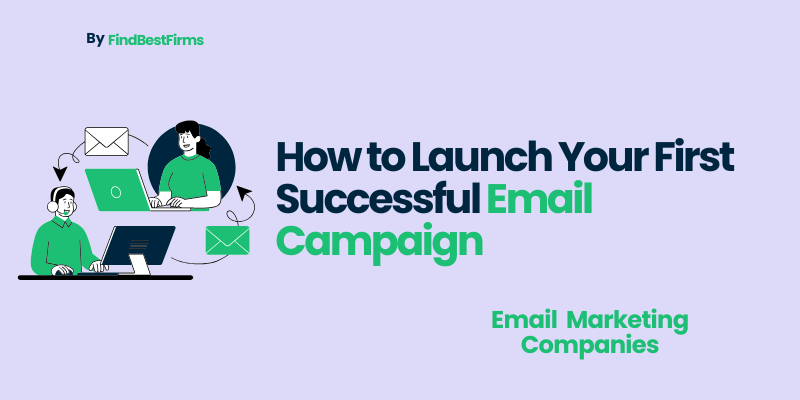The world today is a digital-first one where business firms are competing to attract consumer attention. There is no use denying the fact that social media and paid advertising are the order of the day, but there is always one channel that ensures delivery of long-term result email marketing which is measurable. It is still one of the most affordable methods of getting the customers to the point, cultivating leads and making conversions.
The idea of making your first email campaign can be daunting to start ups, small business owners and entrepreneurs. However, it is one of the most availing steps to take in the direction of creating long-term customer relations when the right approach and guidance are applied. Numerous companies work together with professional Email Marketing Companies to strategize, design and implement campaigns that result in a high level of engagement and quantifiable outcomes. You may be doing it on your own or with professional assistance, but it is important to know the fundamentals of success in the long run.
Tips for Start Successful Email Campaign
Define Your Email Campaign Goals
Before diving into design and content, you must clearly define what you want to achieve with your campaign. Goals act as the foundation for every decision that follows from the tone of your message to the audience you target.
Some common email marketing goals include:
- Promoting a new product or service
- Driving traffic to your website or landing page
- Building brand awareness or credibility
- Re-engaging inactive subscribers
- Generating sales or leads
For example, if your goal is to increase online sales, you’ll need a compelling offer and a strong call-to-action. On the other hand, if your objective is to educate subscribers, your emails should focus on delivering valuable, informative content rather than pushing for a sale.
Setting clear goals not only helps measure success but also guides your content strategy and keeps your campaign focused.
Build and Segment Your Email List
A good email campaign is initiated with a good list. Rather than subscribing to lists that will damage your reputation and deliverability, concentrate on increasing an organic subscriber base. Do something that is worthy of sign-ups, like a discount or a free guide, or exclusive updates.
Segmentation is essential when you get subscribers. Customers do not have similar needs or preferences. This can be achieved by grouping them according to their behavior, demographics or their previous purchases so that you can send more relevant messages.
As an example, a customer who has just bought a product may enjoy a follow-up message with free items, whereas the first-time visitor may need a welcome message that will familiarize them with your brand. Segmentation will enhance interaction, response rates, and responses that make your emails more valuable and effective.
Select the Right Email Marketing Platform
Your email marketing platform serves as the backbone of your campaign. It determines how you design, send, and track your emails. Popular tools like Mailchimp, HubSpot, Brevo, and Constant Contact offer user-friendly interfaces, automation options, and robust analytics.
When selecting a platform, consider factors such as:
- Ease of use: Can you create and send campaigns without needing technical expertise?
- Automation features: Does it support auto-responders and drip campaigns?
- Analytics: Can it track opens, clicks, and conversions effectively?
- Integration: Does it connect seamlessly with your CRM, eCommerce store, or social channels?
Choosing the right tool streamlines your workflow and ensures your first campaign runs smoothly. For beginners, platforms with pre-built templates and drag-and-drop editors are ideal.
Craft Compelling Email Content
The heart of your campaign lies in your content. Great content not only informs but also inspires action. Here’s how to make yours stand out:
a. Write Attention-Grabbing Subject Lines
Your subject line determines whether your email gets opened or ignored. Keep it short, clear, and intriguing. Personalization like including the recipient’s name or referencing a recent action can improve open rates significantly.
b. Create Engaging Body Content
Once opened, your email must deliver value. Write in a conversational tone and focus on what matters most to your audience. Instead of focusing solely on your product, highlight how it solves a problem or adds value to the reader’s life.
c. Add a Clear Call-to-Action (CTA)
Your CTA is where you turn interest into action whether it’s visiting your website, signing up for a webinar, or making a purchase. Use action-oriented language like “Get Started,” “Shop Now,” or “Learn More.”
d. Keep It Visually Appealing
Incorporate relevant images, infographics, and videos to make your email more engaging. However, avoid clutter. A clean, responsive design helps users focus on your message and CTA.
In short, great content combines creativity, clarity, and consistency. Every word should serve a purpose either to educate, engage, or convert.
Design Your Email for Mobile and Accessibility

With over 60% of emails being opened on mobile devices, mobile optimization is no longer optional. A well-designed, responsive email ensures that your message looks great on any screen size, smartphones, tablets, or desktops.
Follow these best practices for mobile-friendly emails:
- Use single-column layouts for easy scrolling
- Keep text short and readable
- Ensure buttons and links are large enough to tap
- Preview your emails on multiple devices before sending
Additionally, make your emails accessible to all readers by using clear fonts, contrasting colors, and alt text for images. This inclusive approach not only broadens your reach but also enhances user experience for everyone.
Schedule and Send Your Campaign at the Right Time
Time is very critical concerning the success of your campaign. The most well-thought-out email may not work when it is sent at the wrong time. Research indicates that open rates might be high in the morning of the weekdays, however this may differ with your audience.
Test and trial to determine the optimal time. A/B testing will enable you to compare various send times and find the most active time of your subscribers.
Also, avoid over-emailing. Excessive sending will result in unsubscribes, whereas insufficient sending will make people forget your business. Much lies in consistency sufficient to remain visible but not obtrusive.
Track and Analyze Campaign Performance

Starting your first campaign is just the start. Real progress happens when you look at how it did and make it better. Most email marketing tools give you detailed numbers like:
- Open Rate: Shows how many people opened your email.
- Click-Through Rate (CTR): Tells you how many clicks on links or buttons.
- Conversion Rate: Keeps track of actions like buying stuff or filling out forms.
- Bounce Rate & Unsubscribes: Point out problems with your list quality or what you're sending.
When you keep an eye on these numbers, you learn what's working and what's not. Use this info to change your subject lines, what you write, and when you send it. As time goes on, these little changes can make things work much better. Keep in mind, email marketing is all about learning and making things better as you go. Every campaign teaches you something new to help you connect with your audience in a better way.
Common Mistakes to Avoid in Your First Email Campaign
Beginners often make a few common mistakes that can hurt performance. Avoiding these pitfalls will help you maintain professionalism and credibility.
- Neglecting Personalization: Generic emails feel impersonal. Use customer data to tailor content.
- Sending Without Testing: Always test for design errors, broken links, and typos before sending.
- Ignoring Analytics: Without tracking, you can’t measure success or improve future campaigns.
- Overloading with Information: Keep emails concise and focused. Readers should instantly understand your message.
- Skipping the Unsubscribe Link: Always include an easy opt-out option; it's both ethical and required by law.
Being mindful of these mistakes helps you maintain a positive sender reputation and ensures your campaigns remain impactful.
Launching your first email campaign is the beginning of your marketing journey. Success doesn't come from a perfect email, it's built from consistency over time, testing, and understanding your audience. Focus on providing value in every message you send. Listen to feedback, track engagement, and develop your strategy based on data-driven insights. With persistence, your campaigns will not only increase conversions but also build lasting relationships with your customers.
If you're ready to take your campaigns to the next level, but need expert assistance, FindBestFirms is here to help. It connects you with top-rated email marketing companies that specialize in creating impactful, data-driven campaigns. Whether you need help with strategy, design, automation, or analytics, these experts can guide you in creating email campaigns that really resonate with your audience. With the right partners and tools, you can turn your first email campaign into a long-term success story that not only boosts conversions but strengthens your brand's digital presence.
In summary
Launching a successful email campaign requires planning, creativity, and a willingness to learn. From setting clear goals to analyzing results, every step plays a role in helping you connect with your audience authentically. With dedication and the right professional support you'll soon master the art of email marketing and unlock its full potential for your business.

